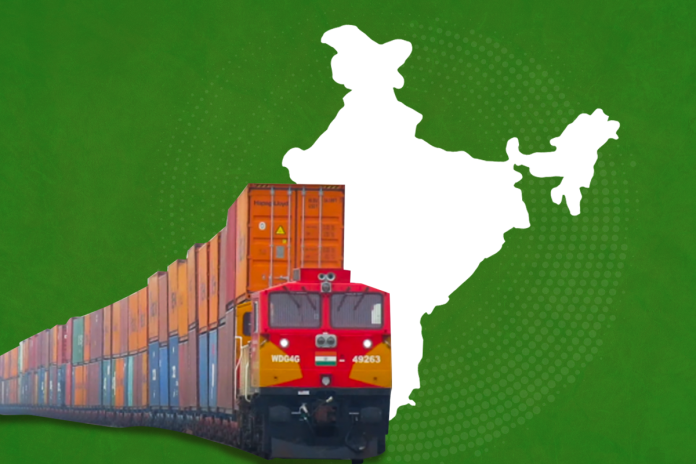India’s transportation landscape is undergoing a revolutionary transformation, spearheaded by the introduction of the Dedicated Freight Corridor (DFC) project.
Stretching from Ludhiana in Punjab to Dankuni near Kolkata in West Bengal, this monumental project stands as one of the most ambitious railway initiatives since India’s independence.
Prime Minister Narendra Modi inaugurated the DFC network on 12th December 2020, hailing it as a game changer for India in the 21st century and a catalyst for rapid national development.
The DFC project is strategically aligned with the National Rail Plan, which sets a bold objective: to increase the railway’s modal share in India from the existing 28 per cent to an impressive 44 per cent by the year 2051.
Crucially, the DFC is not just a railway project; it’s a linchpin of the National Logistics Policy, aiming to reduce logistics costs from the current 15 per cent of GDP to a more sustainable 8 per cent by 2030.
By streamlining freight transportation, the DFC plays a pivotal role in achieving this goal, making the movement of goods more efficient, cost-effective, and reliable.
Furthermore, the DFC’s capacity expansion is instrumental in realising Indian Railways’ ambitious objective of achieving a freight loading capacity of 3,000 MT by 2030.
The Eastern DFC spans a length of 1337 km, while the Western DFC covers an extensive 1506 km, creating a comprehensive network.
This expansive reach aims to ensure a seamless flow of goods and commodities, fostering economic growth and regional development.
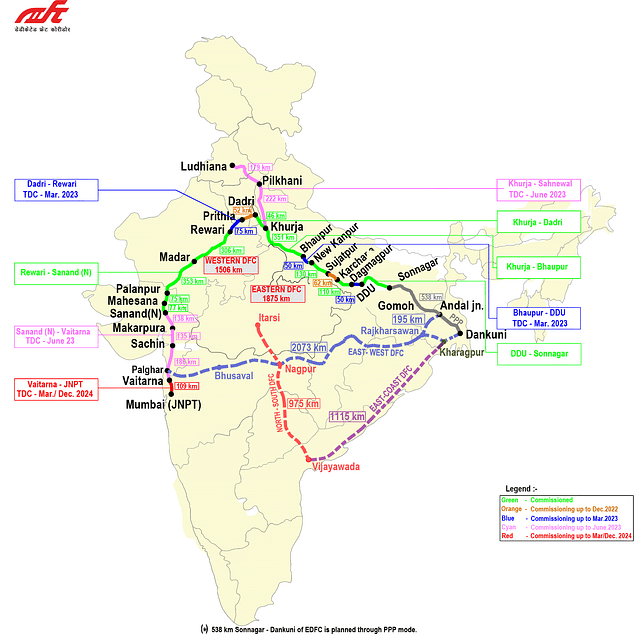
Eastern Dedicated Freight Corridor
The Eastern Dedicated Freight Corridor (EDFC) spans 1,337 km from Sahnewal near Ludhiana in Punjab, crossing through Haryana, Uttar Pradesh, and terminating at Sonnagar in Bihar.
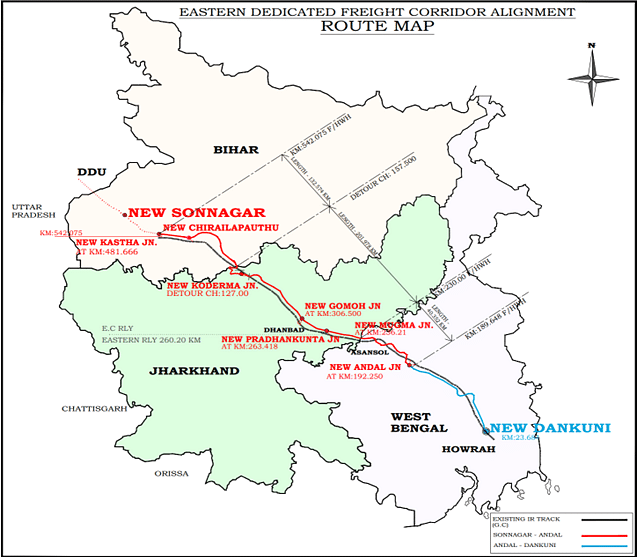
Western Dedicated Freight Corridor (WDFC)
The WDFC, connecting Dadri in Uttar Pradesh to Jawaharlal Nehru Port (JNPT) in Mumbai, passes through five states of UP, Haryana, Rajasthan, Gujarat and Maharashtra.
The western corridor covers a distance of 1,504 km through double line electric (2 x 25 KV) track from JNPT to Dadri via Vadodara-Ahmedabad-Palanpur-Phulera-Rewari. The Western DFC is proposed to join the Eastern DFC at Dadri.
Western DFC would mainly cover Rajasthan (565 km), Maharashtra (177 km), Gujarat (565 km) Haryana (177 km) and about 18 km in Uttar Pradesh.
Alignment has been generally kept parallel to existing lines except provision of detour at Diva, Surat, Ankleshwar, Bharuch, Vadodara, Anand, Ahmedabad, Palanpur, Phulera and Rewari. However, it is entirely on a new alignment from Rewari to Dadri.
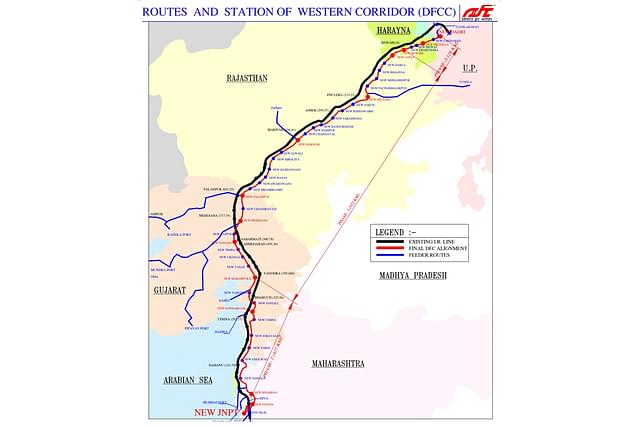
Section wise progress of DFCs
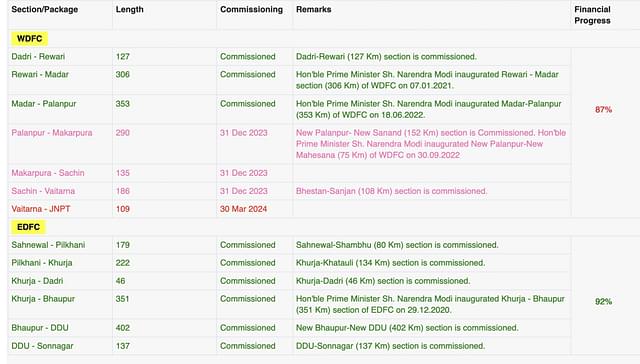
What is the significance of the Dedicated Freight Corridor Project?
The significance of the Dedicated Freight Corridor is multifaceted and holds the potential to reshape the nation’s economic landscape.
Economic Growth and Efficiency
Today, 90 per cent of India’s passenger traffic and 65 per cent of its freight uses road transportation.
The heart of the DFC’s significance lies in its potential to fuel economic growth. Designed exclusively for freight transportation, it aims to enhance the efficiency of moving goods across the vast expanse of India.
The DFC once constructed will decongest the railways’ network by moving 70 per cent of goods trains to these two corridors.
The new electrified freight-only railway lines will allow trains to haul higher loads faster, cheaper, and more reliably than before, enabling the railways to make a quantum leap in their operational performance.
Each kilometre-long freight train on the EDFC will replace some 72 trucks on average. This will ease congestion on India’s overcrowded roads and highways, which carry an overwhelming 60 per cent of the country’s freight, and make the roads safer, as per the World Bank report.
Freight trains travelling on the DFC can achieve higher speeds and carry significantly heavier loads.
This means quicker, cheaper, and more reliable transportation of goods, reducing the disproportionately high logistics costs that have hindered India’s economic potential.
As Benedict L.J. Eijbergen, Program Leader for Economic Integration, and Atul Agarwal, Senior Transport Specialist, and Task Team Leaders for the projects emphasise, “By liberating the freight from the main lines, it will not only enhance passenger rail services but also contribute to efficient urbanisation within this vast corridor. This is particularly significant because we understand that urbanisation plays a crucial role in poverty alleviation in India.”
The DFC, with its potential to reshape freight transportation and passenger services, indeed holds the key to unlocking new opportunities and driving economic progress in the region.
Industrial Development and Regional Revitalisation
One of the most promising aspects of the DFC is its role in fostering industrial development. The establishment of industrial zones at strategic junctions along its route is poised to breathe new life into some of India’s poorest and most densely populated regions.
Currently, almost 90 per cent of the Indian Railway’s freight services are dominated by ten specific bulk commodities.
However, with the expansion of the Dedicated Freight Corridor (DFC) capacity, coupled with faster and more reliable transit times, the Indian Railway stands on the brink of attracting new markets.
These markets will primarily focus on higher-value freight sectors that are presently underrepresented in railway freight services.
The far-reaching impact of this project benefits critical sectors such as power and heavy manufacturing in the northern and eastern states traversed by the corridor.
These industries depend extensively on the railways for the transportation of raw materials and the distribution of their finished and semi-finished goods to both domestic markets and seaports along the eastern seaboard.
This development will not only create jobs but also stimulate economic growth in areas that have traditionally lagged behind in industrialisation.
About 2000 km long Eastern Corridor will pass through Uttar Pradesh and Bihar, bringing jobs and much-needed development to some of India’s poorest regions.
Relieving Pressure on Existing Rail Lines
The separation of freight and passenger traffic is another significant benefit of the DFC. It alleviates the congestion and bottlenecks that have plagued India’s existing railway lines.
According to the World Bank’s estimate, the decongestion of roads along this stretch will also save India some Rs 4.9 billion in logistics costs, with additional benefits of Rs 2.4 billion accruing from reduced pollution.
By freeing up existing rail tracks, the DFC will enhance the speed and reliability of passenger trains on high-demand routes, ultimately improving the overall quality of rail services in the country.
Environmental Sustainability
In a world that is increasingly conscious of environmental concerns, the DFC represents a step towards sustainability.
By diverting a substantial portion of freight traffic from roads to rail, the DFC will help reduce congestion on highways and lower greenhouse gas emissions.
The corridor will rely entirely on electric locomotives, which in turn will result in a substantial reduction in carbon emissions.
A carbon footprint analysis conducted by the Indian Railways indicates that the DFC is expected to generate 2.25 times fewer greenhouse gas emissions over a 30-year period when compared to the conventional business-as-usual approach.
For instance, the Khurja – Bhaupur section alone will decrease the country’s CO2 emissions by some 4.2 million tonnes between 2022 and 2052 and make a significant dent in air pollution.
This reduction in greenhouse gas emissions not only aligns with global sustainability goals but also stands as a testament to India’s commitment to environmental conservation.
Innovation and Modernisation
The DFC is not just a testament to the economic significance of this railway project; it is also a showcase of technological innovation and modern construction methods.
Automation has revolutionised track laying, precision-guided gantries have ensured the accurate placement of rails, and mechanised signalling and telecommunications have streamlined operations.
The implementation of drone technology for monitoring construction progress is a testament to the project’s cutting-edge approach.
In addition, the DFC has heralded a shift in the way India’s railways are managed. Instead of station masters along the route, an advanced Operations Control Center in Prayagraj, one of the world’s largest of its kind, will oversee the entire length of the corridor.
This marks a significant shift from traditional railway operations to a more sophisticated and efficient system.
The permanent way will be constructed with significantly higher design features that will enable it to withstand heavier loads at higher speeds.
Simultaneously, in order to optimise productive use of the right of way, dimensions of the rolling stock is proposed to be enlarged.
Both these improvements will allow longer and heavier trains to ply on the Dedicated Freight Corridors. 25 tn axle load wagons are expected to run on DFC. This will significantly increase throughput on Indian Railways.
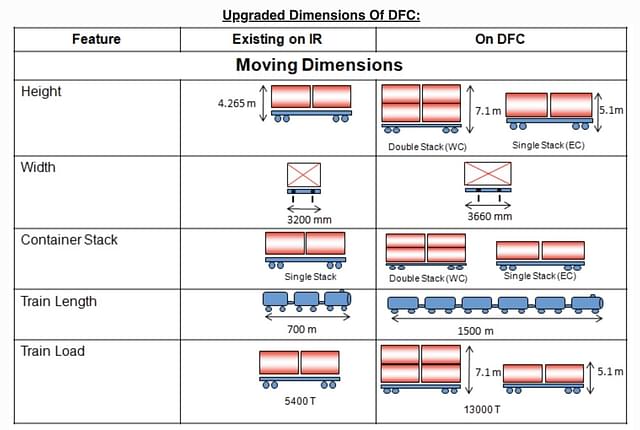
Socio-Economic Impact
Beyond the economic and environmental benefits, it promises to have a profound socio-economic impact. The creation of jobs, the alleviation of regional disparities, and the overall enhancement of transportation services are all facets of the DFC’s significance.
In essence, the Dedicated Freight Corridor (DFC) project stands as a testament to India’s commitment to progress, and it signifies a promising future for a nation that continues to aspire for growth and development on a grand scale.
This project will not only benefit India but also has the potential to serve as a model for other nations looking to enhance their freight transportation systems with sustainability at the forefront.


